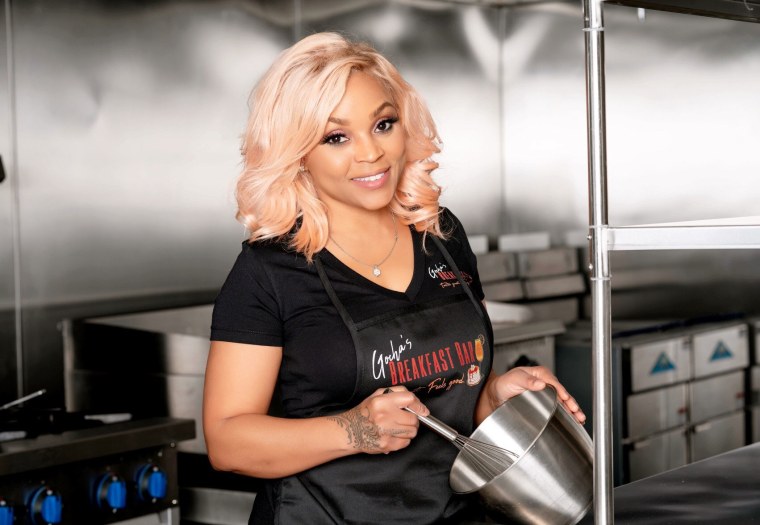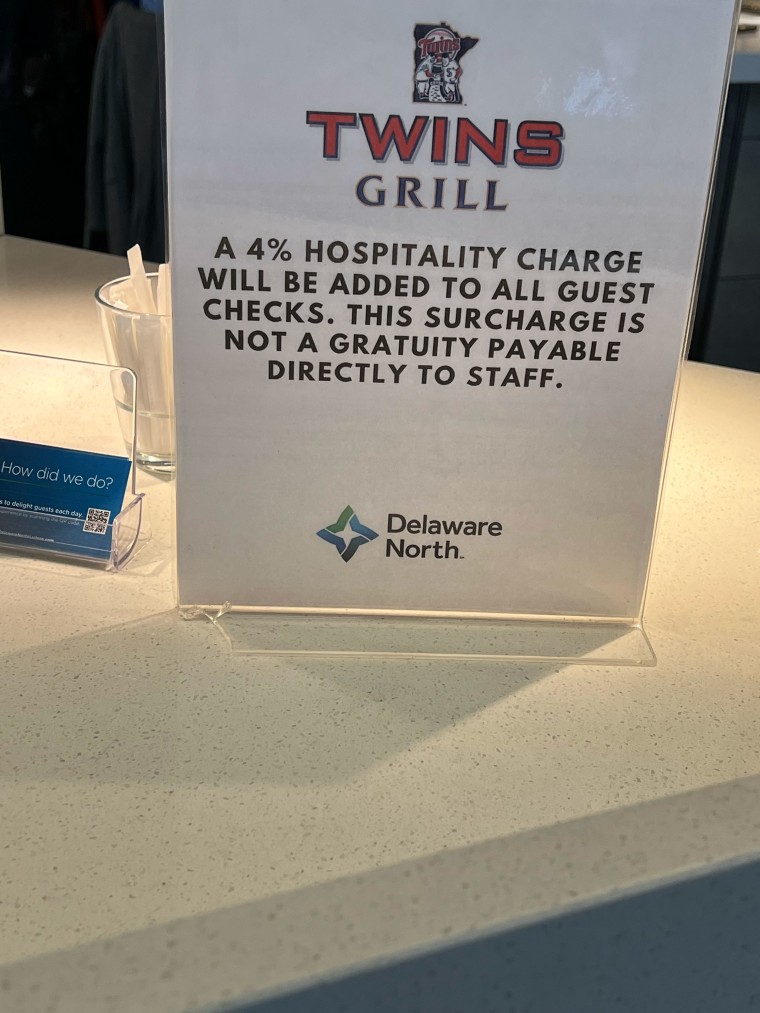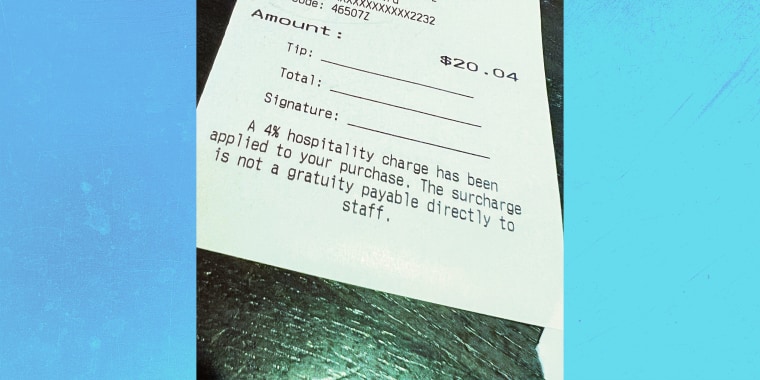Dear Mister Manners: Since when did restaurant customers become responsible for an establishment’s every new expense? I’ve been noticing more and more surcharges popping up on bills at the end of a meal — from inflation fees to penalties for using a credit card. It’s getting out of hand. Should I just lower my tip?
(Mealtime with Mister Manners is a weekly column that delves into a smorgasbord of dining-etiquette dilemmas. Please submit your questions at the bottom of this page.)
Shortly after it opened last summer, several family members and I visited the colorful and sprawling Legoland in Goshen, New York. Touring the park, my nieces and nephews eagerly hopped on the colorful rides as the adults marveled at the scale-model recreations of the world’s great cities.
Once in the car after a fun though not-very-wallet-friendly day, I was stunned to encounter a payment kiosk where departing motorists had to pay a parking fee that had not been advertised upon entry. As if the price of admission and costly concessions were not generating enough revenue, here was one final chance for the park to rack up income. It felt petty and, frankly, put a tinge on an otherwise delightful day.
Just as I did, many diners across the U.S. are now rubbing their eyes when the bill arrives, reviewing line items that were not there before. Unlike the space for a tip, which custom has left to the discretion of patrons and which practice has established at a range of anywhere from 15 to 25%, these new surcharges are fixed amounts. The sums are modest (often from 3 to 5%) but do add up, particularly on a larger tab.
Some restaurant-goers are pushing back, arguing that surcharges are unwarranted and that and their printed explanations on the bottom of our receipts are indefensible. Writer and activist Laureen Narro, whose Aug. 23 tweet called the fee justifications little more than “whining,” gained nearly 50,000 likes on the platform. Clearly, the Twitterverse concurred with her umbrage.
What’s going on?
Why the sudden move to adopt fees? Are restaurants taking a page from the airlines, who long ago saw dollar signs in moving to an à la carte pricing strategy that hits passenger wallets for everything from checking a bag to boarding early? Or from hotels that have decided to add a “resort fee” because, well, they can?
In the case of restaurants, which typically operate on very thin margins, the new surcharges are not a sinister move to bolster the bottom line but rather a genuine — if at times clumsy — attempt to remain in the black despite the twin onslaughts of hefty wholesale price increases and shortages in supplies and labor. These fees are separate and apart from kitchen wellness and staff appreciation fees, which I have covered here previously.
Trying to stay afloat
Vanessa Sink, director of media relations for the National Restaurant Association, explained, “The typical small business restaurant runs on a 3 to 5% pre-tax margin. For the vast majority of restaurant operators — 88% — total food costs are higher now than they were in 2019, and labor costs are up for 86% of operators.” Profits are down, too, with 85% of owners reporting lower numbers than before the pandemic.
Heightening the struggle to stay in business, the bulk of owners are also experiencing increased utility, rent and operating costs. To remain viable, restaurateurs are relying on a variety of strategies, including reducing hours, switching up food options, increasing menu prices and adding surcharges. In the NRA’s August 2022 Restaurant Business Conditions Survey, of 4,200 restaurateurs surveyed, 16% have added surcharges.
Rising costs mean rising prices
Among the 91% of restaurant operators nationwide who have increased menu prices is Gocha Hawkins, owner and head chef of Gocha’s Breakfast Bar, which has locations in Atlanta and Fayetteville, Georgia, along with a food truck. A former hairstylist for celebrities from Beyoncé to Serena Williams, Hawkins made the pivot to the world of dining shortly before the start of the pandemic. To have emerged on the other side with packed restaurants and more in the works has been a success story born of long hours and unwavering commitment to service. And yet, staying afloat has also required Hawkins to continually reassess what she charges patrons.

“I’ve changed my pricing three times since the pandemic,” she said, explaining that her menu pricing is up 20% thanks to inflation. If that jump sounds drastic, consider the radical increases Hawkins has faced for the ingredients that go into crowd-pleasers such as Krunchtastic French Toast, Cajun Creole Lump Fish and Grits, and Betta Than Yo Momma Biscuits.
Hawkins enumerates the spikes as easily as she would once have discussed the cost of highlights or a relaxer: “When I started, flounder cost $49 a case; it’s now $92. Eggs were $34; we’re now paying $62. Chicken was $80 a case; it’s now $189.”
Beef has gotten so expensive, she has simply taken it off the menu.
Though her patrons may be feeling the sting of these increases, the crowds keep coming. This despite the fact that Hawkins has also instituted a 20% service charge for all takeout orders and a 20% service charge for parties of more than five or for tabs in excess of $75.
Dining at Gocha’s Breakfast Bar is undoubtedly more costly than before, but Hawkins remains mindful that along with higher pricing come high expectations. “I stand by my product, I stand by my service,” she said. “When you have those two things in place, price is not a factor.”
What’s next?
If you’re concerned that charges for tap water and silverware will be next, rest assured the vast majority of restaurant owners have no intention of shell-shocking us the way Brooklyn-based foodie George Britton was as he traveled through Italy while still an undergraduate.
In Milan, in 2008, his bill at a pizzeria included a charge for napkins. “Who eats pizza without using at least one napkin?” he asked, but was summarily told that the restaurant incurs a cost to provide linens. “I’m still not sure why I wasn’t charged for sitting on a chair or using my utensils to eat my food, since these items also require costs to maintain,” he said, only half jokingly.

Two years later, in Florence, he actually was charged for the chair he was sitting in, or more specifically, the orientation of his chair. “My chair faced the piazza and, apparently, only a limited number of chairs had that view.” Even though he and his dining companion ordered more or less the same dish, Britton’s tab was a couple Euros more. He recalled: “The owners felt that it was necessary to charge more for the ‘exclusive’ experience.”
To this day, to avoid such unpleasant surprises, Britton kids that he rarely dines at restaurants with a piazza view.
What does all this mean for tipping?
Whether you are in Florence with a piazza view or in Flagstaff with a cactus view, it’s vital to remember that these newly instituted surcharges do not line the pockets of your server, and as such, a patron should not scrimp on gratuity. Servers have no say over surcharges let alone the rate of inflation.

Nonetheless, when calculating your tip, you may do so excluding any non-service-related surcharges. Tip on the cost of your meal and — if you so choose — include the tax when doing so. But the surcharges may be viewed as separate and apart from your gratuity determination.
Are the fees here to stay?
While some restaurant patrons grumble that restaurant owners should just raise prices and do away with surcharges, they may want to be careful what they wish for. Although the National Restaurant Association’s survey found that three-quarters of restaurants anticipate needing to keep the fees in place for a year or more, when inflation eventually drops, the fees should drop away also.
On the other hand, once a menu item reaches a price milestone, chances of its going back down are less likely. Said Hawkins, “I’ve already put the price out there. There’s no need to go backwards."
In one form or another, then, it seems we’ll be paying more for dining out for the foreseeable future. Yet, for those who love nothing more than the enjoyment of sampling the cuisine of a restaurant that always gets it right, the higher tabs will likely be a reality we simply come to accept.
Submit your dining etiquette questions here:


